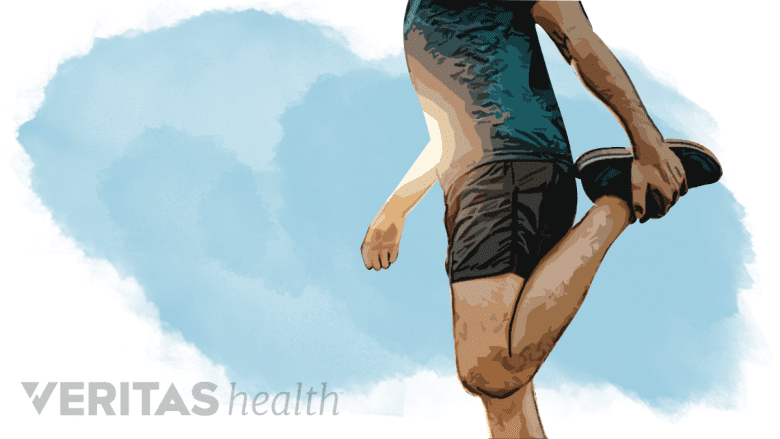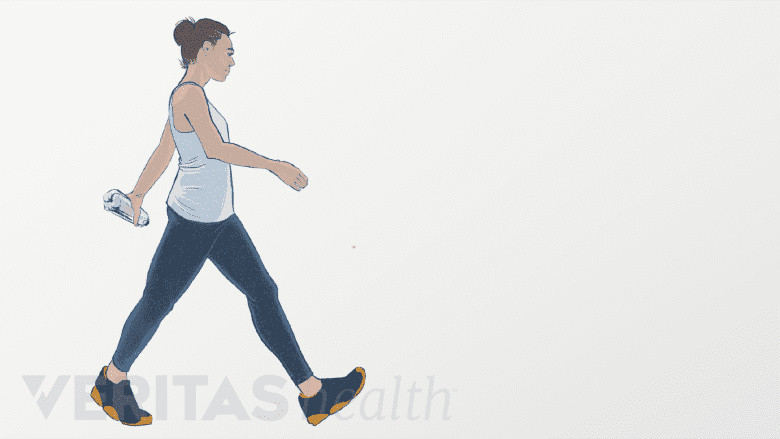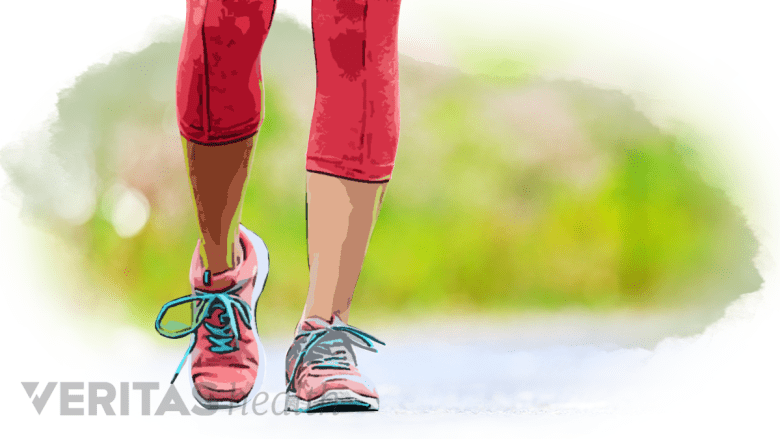There are several stretches and techniques that improve the benefits of exercise walking, as well as help prevent injury or pain.
In This Article:
- How Walking Improves Back Health
- Techniques for Effective Exercise Walking
- Video: 2 Walking Tips to Avoid Sciatica Pain
- 2 Walking Tips for Piriformis Syndrome Video
Warm-up: Stretch Before Walking
Stretching is essential to prepare the muscles, improve flexibility, and reduce the risk of injuries.
Before exercise walking, gentle stretching should be done to prepare the joints and muscles for the increased range of motion needed.
Easy stretches to warm up before walking include:
- Leg swings. Stand beside a wall or sturdy support and gently swing one leg forward and backward. Repeat this motion for 10 swings on each leg.
- Hip circles. Stand with feet hip-width apart and place the hands on the hips. Make a gentle circular motion with the hips, rotating them clockwise and then counterclockwise for 10 circles in each direction.
- Calf stretches. Find a wall or a step and place the ball of one foot against it while keeping the heel on the ground. Lean forward slightly to feel a stretch in the calf muscles. Hold for 10 to 30 seconds on each leg. Keep the back straight while leaning forward at the hip.
- Thigh stretches. Stand tall and bring one heel towards the buttock, holding the ankle with the hand. Gently pull the heel closer to the body until a stretch is felt in the front of the thigh. Hold for 15 to 30 seconds on each leg. If balance is an issue, hold onto the back of a chair or a counter with the free hand.
Perform these stretches with gentle and controlled movements.
Gradually Increase Walking Pace and Intensity
For beginners, aim for a slow pace and start with a small goal of walking a mile or for 20 minutes. It is essential to listen to the body when starting. If walking for 20 minutes causes discomfort, begin with shorter intervals of 5 or 10 minutes throughout the day and gradually increase the duration over time.
Moderate-intensity exercise walking or walking at a brisk pace is the most beneficial pace for walking to improve cardiorespiratory fitness and muscular strength.1Bai X, Soh KG, Omar DR, Talib O, Xiao W, Cai H. Effect of brisk walking on health-related physical fitness balance and life satisfaction among the elderly: a systematic review. Front Public Health. 2022;9:829367. http://doi.org/10.3389/fpubh.2021.829367 Moderate intensity is usually associated with walking a mile in 20 minutes or less at a target heart rate of 64% to 76% of an individual’s maximum heart rate.1Bai X, Soh KG, Omar DR, Talib O, Xiao W, Cai H. Effect of brisk walking on health-related physical fitness balance and life satisfaction among the elderly: a systematic review. Front Public Health. 2022;9:829367. http://doi.org/10.3389/fpubh.2021.829367
Maintain Correct Posture for Exercise Walking
Ensuring proper posture is crucial to protect the back and promote healing.
Maintaining a correct posture is essential to help protect and heal the back.
The posture guidelines for exercise walking include:
- Head: Keep the head up, facing forward, and aligned with the spine
- Shoulders: Relax the shoulders and keep them pulled back and down, avoiding rounding or hunching
- Chest: Lift the chest slightly to open up the airways and facilitate deeper breaths
- Arms: Swing the arms naturally, bent at a 90° - 120° angle, allowing them to swing back and forth in coordination with the stride
- Core: Engage the abdominal muscles by pulling the stomach in towards the spine and stand fully upright
- Hips: Keep the hips aligned with the torso and facing forward, avoiding excessive side rolling
- Feet: Land on the heel, roll through the ball of the foot, and push off the toes, allowing for a smooth gait
It may take some practice to walk with the correct posture. If unsure, consult a physical therapist for guidance.
Choose the Right Walking Shoes for Stability and Support
Good walking shoes provide essential support and comfort during walks.
Walking shoes with the following characteristics help provide stability and support:
- Cushioning. Cushioning in the sole of the shoes absorbs the shock of walking and reduces the impact on the spinal joints.2Cambron JA, Dexheimer JM, Duarte M, Freels S. Shoe orthotics for the treatment of chronic low back pain: a randomized controlled trial. Arch Phys Med Rehabil. 2017;98(9):1752-1762. http://doi.org/10.1016/j.apmr.2017.03.028
- Arch support. The natural alignment of the feet is provided by shoes with arch support.
- Stability. Shoes with a wide and stable base promote balance and prevent excessive side-to-side rolling of the heel.3Hong W-H, Lee Y-H, Lin Y-H, Tang SFT, Chen H-C. Effect of Shoe Heel Height and Total-Contact Insert on Muscle Loading and Foot Stability While Walking. Foot & Ankle International. 2013;34(2):273-281. http://doi.org/10.1177/1071100712465817 A walking shoe should snuggly fit around the heel.
- Flexibility. Ensure the shoes are flexible enough to allow the feet to move naturally while walking. The shoes should bend at the ball of the foot, supporting a smooth stride.
- Correct fit. The shoes should have enough room in the toe to wiggle the toes comfortably and not feel too tight or loose.
Consult a shoe store specializing in walking shoes to assess foot type and gait. A musculoskeletal, sports, or spine specialist may also provide information and recommendations for custom orthotic inserts.
Consider Using Orthotic Inserts for Additional Support
Orthotic shoe inserts may address specific foot conditions or provide extra comfort, such as:
- Foot type. Orthotic inserts may address different foot types, including arch height and biomechanical abnormalities such as wide or narrow feet.
- Pronation. Determine if the foot pronation is either normal pronation (foot rolls slightly inward), overpronation (foot rolls excessively inward), or supination (foot rolls outward). Different shoes and orthotic inserts are designed to accommodate these different pronation patterns.2Cambron JA, Dexheimer JM, Duarte M, Freels S. Shoe orthotics for the treatment of chronic low back pain: a randomized controlled trial. Arch Phys Med Rehabil. 2017;98(9):1752-1762. http://doi.org/10.1016/j.apmr.2017.03.028
Store-bought orthotics may be relatively inexpensive compared to custom-made orthotics but are nonspecific for discrepancies between the left and right foot.4Chuter V, Spink M, Searle A, et al. The effectiveness of shoe insoles for the prevention and treatment of low back pain: a systematic review and meta-analysis of randomized controlled trials. BMC Musculoskelet Disord. 2014;15:140. http://doi.org/10.1186/1471-2474-15-140
Choose the Right Environment: Walking Outside or Using a Treadmill
Walking outside offers a refreshing and revitalizing experience.
Walking outdoors or using a treadmill indoors is largely a matter of personal preference.
The relative benefits of walking outside include:
- Fresh air and natural surroundings. Walking in the fresh air and a natural environment may improve mood and reduce stress.5Noseworthy M, Peddie L, Buckler EJ, Park F, Pham M, Pratt S, Singh A, Puterman E, Liu-Ambrose T. The Effects of Outdoor versus Indoor Exercise on Psychological Health, Physical Health, and Physical Activity Behaviour: A Systematic Review of Longitudinal Trials. International Journal of Environmental Research and Public Health. 2023; 20(3):1669. https://doi.org/10.3390/ijerph20031669
- Varied terrains and inclines. Walking on different terrains and inclines challenges the muscles, promoting increased strength and endurance.
- Sunlight exposure. Walking outdoors during the day allows the body to produce vitamin D from sunlight, benefiting bone health and immune function.5Noseworthy M, Peddie L, Buckler EJ, Park F, Pham M, Pratt S, Singh A, Puterman E, Liu-Ambrose T. The Effects of Outdoor versus Indoor Exercise on Psychological Health, Physical Health, and Physical Activity Behaviour: A Systematic Review of Longitudinal Trials. International Journal of Environmental Research and Public Health. 2023; 20(3):1669. https://doi.org/10.3390/ijerph20031669
Walking outside also provides an opportunity to engage in social interactions while exercising. Walking with friends and family or joining walking groups may make exercise more enjoyable, encouraging regular participation and accountability.
The relative benefits of using a treadmill for exercise walking include6Bello B, Adeniyi AF. Effects of lumbar stabilisation and treadmill exercise on function in patients with chronic mechanical low back pain. Int J Ther Rehabil. 2018;25(9):493. http://doi.org/10.12968/ijtr.2018.25.9.493:
- Convenient and weather-independent. Walking indoors provides a consistent and controlled environment regardless of weather conditions, enabling exercise at any time.
- Customizable settings. Walking on a treadmill enables control over the pace and incline of the exercise, enabling individuals to adjust their workout to their fitness level.
- Safety features. Treadmills have handrails for support and stability and an emergency stop and may benefit anyone with a spinal condition with symptoms such as leg weakness, leg or foot numbness, or balance issues.
- Monitoring and feedback. Treadmills often provide real-time feedback on distance, time, pace, calories burned, and heart rate. This information may be used to track long-term progress and ensure that the individual is exercising within their target heart rate zone.
Using mobile applications or preprogrammed exercises on a treadmill that gamifies and/or guides exercises may be another beneficial way of making exercise more enjoyable and fulfilling.
- 1 Bai X, Soh KG, Omar DR, Talib O, Xiao W, Cai H. Effect of brisk walking on health-related physical fitness balance and life satisfaction among the elderly: a systematic review. Front Public Health. 2022;9:829367. http://doi.org/10.3389/fpubh.2021.829367
- 2 Cambron JA, Dexheimer JM, Duarte M, Freels S. Shoe orthotics for the treatment of chronic low back pain: a randomized controlled trial. Arch Phys Med Rehabil. 2017;98(9):1752-1762. http://doi.org/10.1016/j.apmr.2017.03.028
- 3 Hong W-H, Lee Y-H, Lin Y-H, Tang SFT, Chen H-C. Effect of Shoe Heel Height and Total-Contact Insert on Muscle Loading and Foot Stability While Walking. Foot & Ankle International. 2013;34(2):273-281. http://doi.org/10.1177/1071100712465817
- 4 Chuter V, Spink M, Searle A, et al. The effectiveness of shoe insoles for the prevention and treatment of low back pain: a systematic review and meta-analysis of randomized controlled trials. BMC Musculoskelet Disord. 2014;15:140. http://doi.org/10.1186/1471-2474-15-140
- 5 Noseworthy M, Peddie L, Buckler EJ, Park F, Pham M, Pratt S, Singh A, Puterman E, Liu-Ambrose T. The Effects of Outdoor versus Indoor Exercise on Psychological Health, Physical Health, and Physical Activity Behaviour: A Systematic Review of Longitudinal Trials. International Journal of Environmental Research and Public Health. 2023; 20(3):1669. https://doi.org/10.3390/ijerph20031669
- 6 Bello B, Adeniyi AF. Effects of lumbar stabilisation and treadmill exercise on function in patients with chronic mechanical low back pain. Int J Ther Rehabil. 2018;25(9):493. http://doi.org/10.12968/ijtr.2018.25.9.493
Editor’s Top Picks
- Video: 2 Walking Tips to Avoid Sciatica Pain
- How to Start Walking Program When You Have Low Back Pain Video
- 2 Walking Tips for Piriformis Syndrome Video
- Advantages and Disadvantages of Treadmill Use for Exercise and Pain Relief
- 2 Walking Tips to Avoid Sciatica Pain
- 4 Easy Stretches for Lower Back Pain Video









